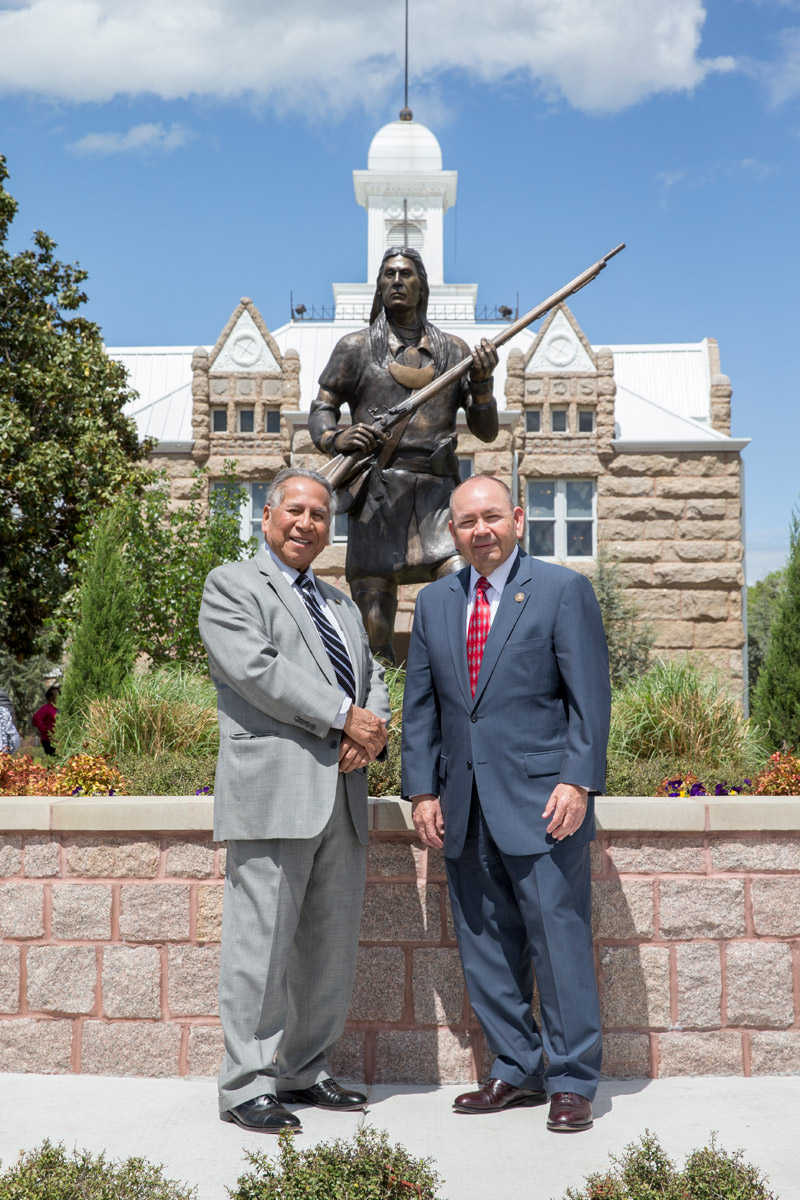

TISHOMINGO, Okla. – An April ceremony dedicated a statue to a man who is arguably one of the most important and influential Chickasaws in modern history.
Chickasaw Nation Governor Bill Anoatubby led the April 28 event honoring Piominko.
For generations, people called him Piomingo. The tribe, through historical research and in consultation with its language department, discovered the great Mountain Leader should be addressed as Piominko.” “Minko” is Chickasaw for “leader.”
A large gathering of Chickasaw Nation and Tishomingo community dignitaries corrected the name and formally recognized the statue on the grounds of the historic Chickasaw Nation Capitol as that of “Piominko.”
“We are going back to our roots and calling people by their proper title,” Gov. Anoatubby told the gathering on a spectacular April afternoon.
Piominko and President George Washington enjoyed a personal relationship, Gov. Anoatubby said. They both signed the 1786 Treaty of Hopewell which formalized the Chickasaw Nation’s alliance with the fledgling federal government and “defined the tribal boundaries,” Gov. Anoatubby said.
He is honored for his greatness and visionary actions benefiting the Chickasaw Nation and for enhancing the overall quality of life of the Chickasaw people, Gov. Anoatubby added.
When American colonists plunged headlong into the Revolutionary War, Piominko allied with them rather than the Spanish.
“In a bold move, and one that turned out to be one of his greatest achievements, he acted as a tribal diplomat in order to protect tribal sovereignty,” Gov. Anoatubby explained.
When the smoke cleared with victory for the colonists, Piominko was there to build partnerships with the new Americans.
The sculpture – painstakingly crafted for more than three years by internationally renowned Oklahoma artist, ex-state political leader and former Seminole Nation Principal Chief Enoch Kelly Haney – now guards the historic Capitol. Piominko is cautious; a steely eye is peeled for danger; a tomahawk is tucked securely in his waistband. Other necessities are packed in his “possibles” bag. The greatness of Piominko and his importance to the Chickasaw Nation is fully on display.
“My team and I researched Piominko through historical records and accounts. We paid attention to the smallest of details to ensure the work was historically accurate,” Haney said following the dedication ceremony.
Haney’s sculpture of Piominko shows the great Chickasaw leader in traditional post-European contact attire, sporting a peace medal presented to him by President Washington, along with the traditional Chickasaw gorget. Gov. Anoattuby praised Haney as “honoring us again with a great work of art.”
Haney also crafted the Chickasaw Warrior sculptures proudly displayed at the tribe’s headquarters and the Chickasaw Nation Medical Center, both in Ada, and the Chickasaw Cultural Center in Sulphur.
Piominko was born in Mississippi around 1750 and played a huge role in protecting the Chickasaw Nation and the lower Mississippi River valley from invaders, warlords, foreign intruders and enemies of the tribe.
Piominko effortlessly split his endeavors between two worlds – Native and non-Native. It is believed he lived in western Tennessee and among Chickasaws in northern Mississippi throughout his lifetime.
On Jan. 10, 1786, Piominko signed the Treaty of Hopewell and was later welcomed to Washington’s home in Philadelphia July 11, 1794.
Piominko received a commission as an officer of the militia from President Washington. He received something else from President Washington that would resonate throughout Chickasaw culture. It was a full-length military jacket. A statue of Piominko in Tupelo, Mississippi, shows him wearing a military jacket. Its double-breasted splendor became a fashion adopted by many Chickasaw men of the era. Chickasaws included them in their everyday clothing and made them uniquely Chickasaw through cultural accessories, such as gorgets.
The aging Piominko (49 was considered elderly in the 18th century) made his last public appearance in July 1797. He and William Colbert were successful in winning approval for the site of a new fort at the present day Auction Square in Collierville, Tenn.
Piominko provided strong leadership. He acted as a diplomat to protect Chickasaw sovereignty. He met with other southeastern tribes, governors of states and President Washington to reach agreements benefiting Chickasaws.
Little is known of Piominko’s death, although it very likely occurred in the winter of 1798 or early 1799. The end probably came in a Chickasaw village near present-day Tupelo, Mississippi.
